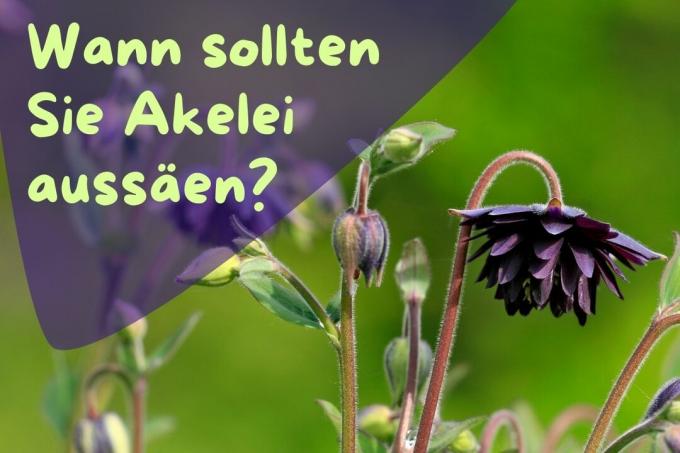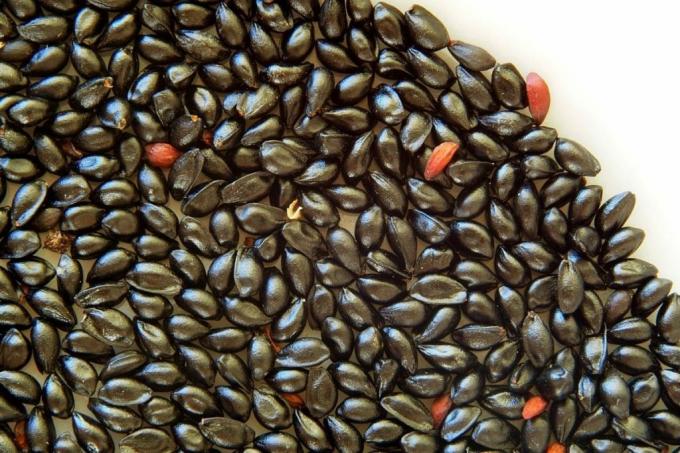
table of contents
- Best time to sow
- Prefer seeds
- Stratify cold germinating species
- Sowing Columbine - Instructions
- After sowing
- frequently asked Questions
The Columbine is an attractive flower with an unusual shape. It transforms one or the other area of the garden into a beautiful sea of flowers. The cultivation is completely uncomplicated. We show when to sow columbine.
In a nutshell
- Seeds for sowing can be harvested from existing plants
- they can be preferred in the house or sowed directly
- some species require a cold stimulus for germination
- others can be sown directly in the field
- the seeds of the Columbine are poisonous
Best time to sow
Regardless of whether the seeds were bought or harvested in the previous year, the right time to sow the seeds depends Columbine depends on whether it is a preculture or no-till and whether the seeds are stratified beforehand got to. If a preculture is pending in the house, you can start with it from the end of February. If you want to sow directly in the bed, the right time is between the end of April and the beginning of May. The seeds usually do not mind the cool temperatures.
Note: Direct sowing in autumn is not recommended because, unlike the seeds, the young plants are sensitive to frost. Columbines that you want to sow outside in autumn would therefore not survive the first winter.
Prefer seeds
For a preculture in early spring, a seed box and a cold frame are just as suitable as a commercially available seed tray. Furthermore, you need conventional sowing soil and of course the appropriate seeds.

- first fill the respective receptacle with seed compost
- Spread seeds on the substrate
- Cover a maximum of three to five millimeters with soil
- Moisten the soil and keep it moist until germination
- ideally use a hand sprayer
- put the whole thing in a bright place without direct sun
- optimal germination temperature between 17 and 20 degrees
- Germination time around five to six weeks
- from a size of approx. Singulate five centimeters by 30 cm
- put out or plant after the ice saints
- Protect young plants from possible late frosts
If you do not want to use purchased seeds, you can also harvest them in autumn from existing plants and sow them. The seed pods form after flowering and can be harvested as soon as they are withered or wilted. are dry. If you shake the capsules and the capsules rustle, the seeds are ripe and can theoretically be sown.
Note: Columbine seeds are like all other parts of the plant poisonous.
Stratify cold germinating species
The frost germs among the columbines such as B. Aquilegia chrysantha can be sown in the garden very early in the year or in autumn from October to December. They need a cold stimulus lasting four to eight weeks to germinate. You can also sow them in seed pots and place them in a 15-18 degree cool place for three to four weeks. Then move to a slightly cooler place for about a week with temperatures of approx. 10 degrees. On frost-free days in January they can be moved to a sheltered location outdoors.
Sowing Columbine - Instructions
Not all Columbine species are cold germs and can therefore be sown normally in spring. Before thinking about sowing, it is important to find the right location, because not every species thrives equally well in every location. Many plants in shady locations only reach a third of their possible height. Sunny and especially partially shaded areas in the garden are more suitable. Once the right location has been found, the seeds can be sown.

- Sow columbine in loose, humus rich, fresh and nutrient-rich soil
- sandy-loamy substrates are ideally suited
- then do not dry out as quickly
- Waterlogged floors completely unsuitable
- Thoroughly loosen the soil in the bed, about 20-30 cm deep
- remove weeds, roots and stones
- Mix soil with compost
- then sow the seeds thinly on loosened soil
- Cover lightly with soil, moisten the soil and keep it moist
- If necessary, mix the seeds with a little sand before sowing
- Spreading is then easier and more even
Tip: To prevent the seeds from being washed away during watering, the soil can be moistened before sowing. In addition, when it rains, the seeds can be protected with a foil tunnel that is placed over the bed.
After sowing
The first seedlings can usually be seen after about four to six weeks. If the seeds have been sown too densely, prick out as soon as they have formed the first leaves and are large enough. Weak plants and those with poor growth are sorted out and only the strongest and healthiest ones are used for cultivation. After the young plants have been isolated, they are actually very easy to care for. Depending on the amount of natural rain, they should be watered regularly and fertilized from May to August. If you remove withered flowers, it is even possible to re-bloom. In the next spring, they will then be cut off near the ground.
Tip: When watering, always pour on the root area and not over the leaves or flowers.
frequently asked Questions
These plants bloom for the first time after a year. Failure to flower usually has nothing to do with sowing.
The Columbine usually sows itself. However, different varieties can lead to undesirable crossings in a confined space. The resulting offspring are then not single-variety.
The columbine is one of the so-called light germs. This means that they need a certain amount of light to germinate. Therefore, after sowing, you should only cover them with a very thin layer of earth. In general, seeds of light germs are very small, so that they would hardly be able to penetrate a thick layer of soil.



